
12 minute read
WAYS WITH TILES A guide to adding colour and pattern, inside and out
Creative ways with TILES
Be bold with colour and elaborate with design to add decorative charm inside and out
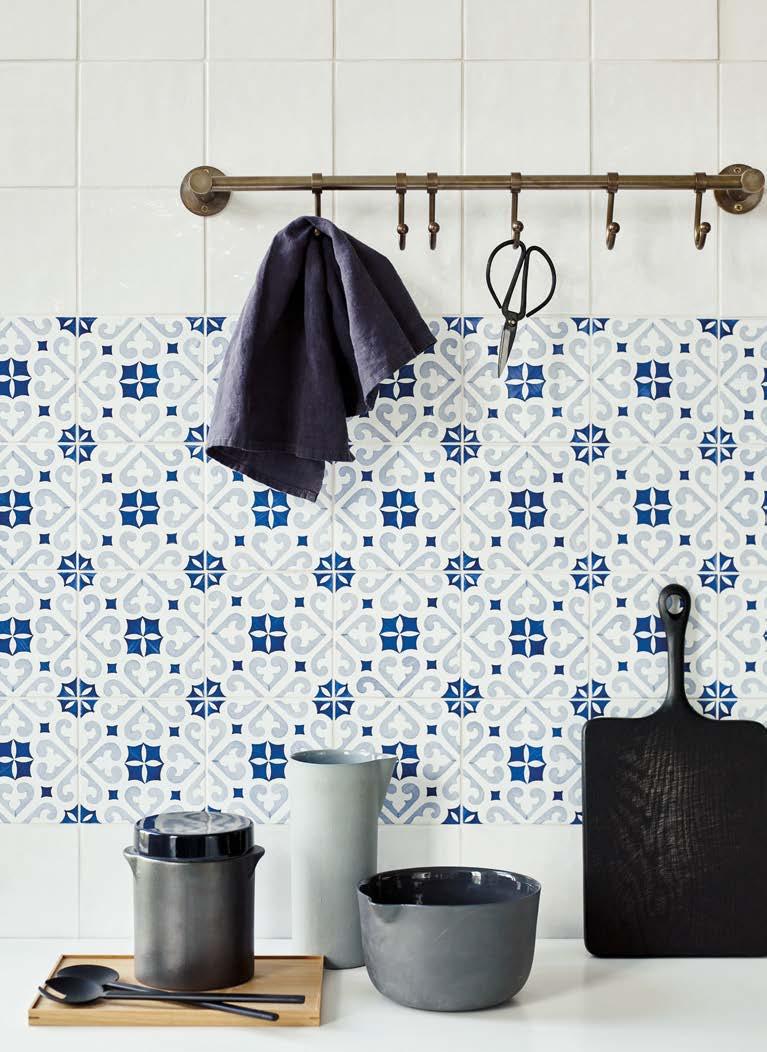
From natural stone to painted ceramic designs, tiles have long been used to create practical yet decorative surfaces in the home. Nowadays, with myriad shapes, sizes, colours and configurations on offer, it is easier than ever to enliven a decorating scheme with tiles. “Tile options have come a long way from the utilitarian choices our grandparents were faced with,” Rob Whitaker, creative director at Claybrook, says. “Decorative patterns in bold hues for floors sit happily alongside wall tiles that burst with eye-catching colours or are in natural materials in interesting shapes.”
Here we look at ways this practical and beautiful medium can be used throughout the home. In a kitchen, select tile designs that balance aesthetics with functionality, bearing in mind that smooth-surfaced tiles will be easier to keep clean than textured varieties.
Consider using a combination of patterned and plain tiles to introduce decorative interest, such as a hand-painted mural or panels above a cooker, or a colourful, patterned frieze across a wall. Tiles in richly coloured or subtle tonal glazes produce dramatic variations, adding a dash of the extraordinary to what might otherwise be a utilitarian kitchen space.
For a traditional look, seek inspiration from country house kitchens and seek out the uneven character of handmade tiles with a crackle glaze in muted hues to inject period charm.
WONDER WALLS
ABOVE LEFT Add decorative interest and rustic charm with panels of hand-painted tiles depicting farmyard scenes or motifs, landscapes and fl orals. Cockerel six-tile panels, £133.90 each, Marlborough Tiles ABOVE Patterned tiles inject a band of colour between a co-ordinating plain alternative. Cabrera Jasmin Blue tiles, £4.49 each; Cabrera White Gloss tiles, £1.19 each, Claybrook Studio
A GOOD VINTAGE
Readily sourced from reclamation yards or specialist suppliers, antique tiles have a particular charm and appeal. As Chris Gulson-Brooke, founder of Maitland & Poate explains, “Reclaimed tiles lifted from the floors of heritage properties will display tiny chips and variations in patina from many years of previous use. Its these variations in the tiles that makes them so beautiful.”
Plain antique stone and terracotta tiles boast a depth of colour and variation in tone not found in modern counterparts, and patterned encaustic tiles are very versatile, with just a small quantity needed for a pretty splashback or floor for a walk-in shower. Alternatively, use a selection of different designs together to create a patchwork effect or juxtapose with sections of reclaimed parquet timber or exposed brickwork to further complement their rustic, salvaged charm.
RIGHT These 100-year-old antique terracotta tiles are wonderfully worn and full of character. They can be used to add period charm to an entrance hall or kitchen. Antique Burgundy Reclaimed Terracotta, £153.76 a square metre, Artisans of Devizes

STYLISH EMBELLISHMENT
Elevate the design credentials of the classic brick tile with solid colour blocking and a mix of confi gurations. Shoreline Ceramic Glazed Gloss tiles in Sunset (top) and Shingle (bottom) £79.80 a square metre, National Trust Tile Collection at The Sarsen Stone Group Bold use of pattern and colour, combined with clever configuration, can make a bathroom very beautiful indeed. For a modern twist on tradition, take classic brick tiles and experiment with different ways to position them. Lay them horizontally to make a room appear wider, and vertically to visually heighten a space, or herringbone-style for a pretty decorative look. For dramatic results, position blocks of solid, contrasting colours next to each other, whilst for a more subtle application of colour, use slender pencil tiles in bright hues to create a stripe effect.
Cement tiles can be suitable for both walls and floors, so use ornate patterned designs strategically to create visual cohesion in a small wet room or to ‘contain’ a bathing area within a larger space.
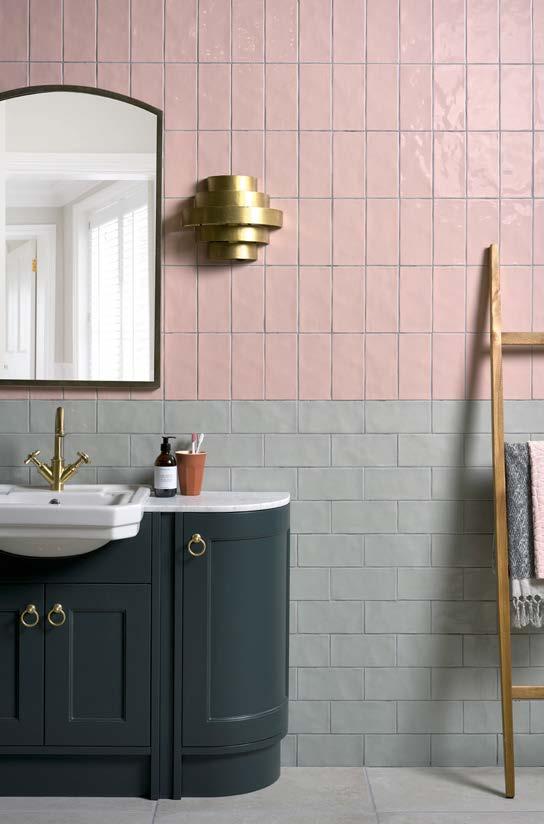
BELOW A simple star motif is suffi cient to add playful pattern to a zoned bathing area of plain tiles. Luna Fennel tiles, £5.10 each; Plain Fennel tiles, £3.36 each, all Bert & May
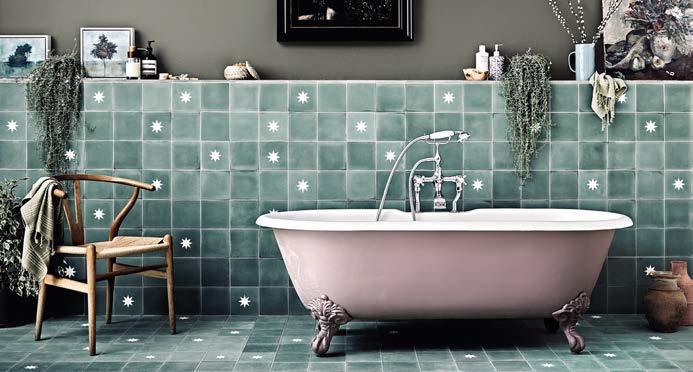
BORDERLINE
Use pattern to create cameos of interest by mixing tile designs and colours. Many patterned tiles come with accompanying border designs to create a rug-effect central panel in a room or to zone a section of a room for a specific purpose. As Colin Roby-Welford, creative director at Fired Earth, explains, “Border and corner tiles give floors a really ‘finished’ look, framing the floor and ensuring that it takes centre stage.”
Alternatively, a simple striped tile or a plain tile with a relief decoration can be used to create effective borders for more elaborate designs, particularly where a single colour is used, resulting in a calm, cohesive overall result. Border tiles can also be used as a dado-rail-style wall divider with different styles and designs of tile above and below.
TOP Tiles depicting traditional motifs in heritage colours add authentic charm to a period home. Use a border tile in a hallway or boot room to create a ‘rug’ or ‘door mat’ effect. Patisserie Sucre 2 and Patisserie Sucre Border tiles, both £3.14 each, Fired Earth RIGHT A striped tile acts as the perfect frame for a delicate leaf-patterned tile in this sophisticated but playful bathroom scheme. Felce tiles, £8.04 each; Stripes tiles, £11.79 each, both Balineum
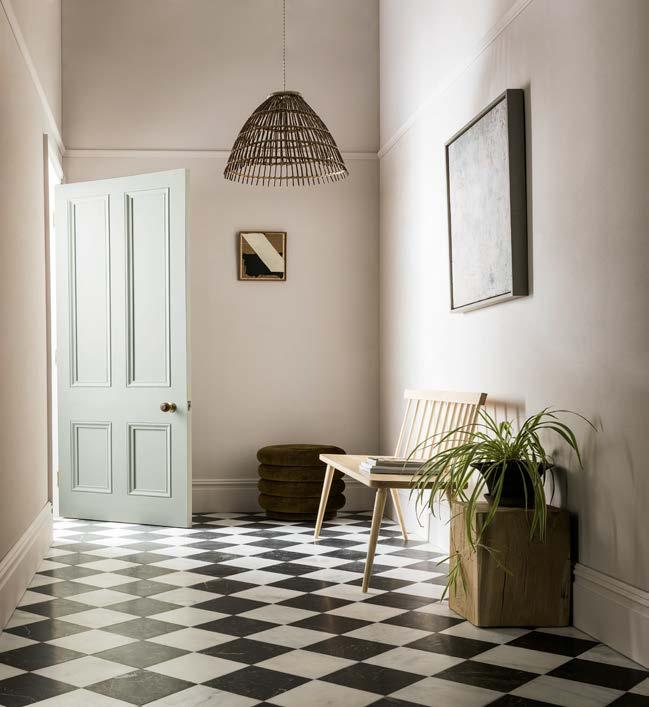
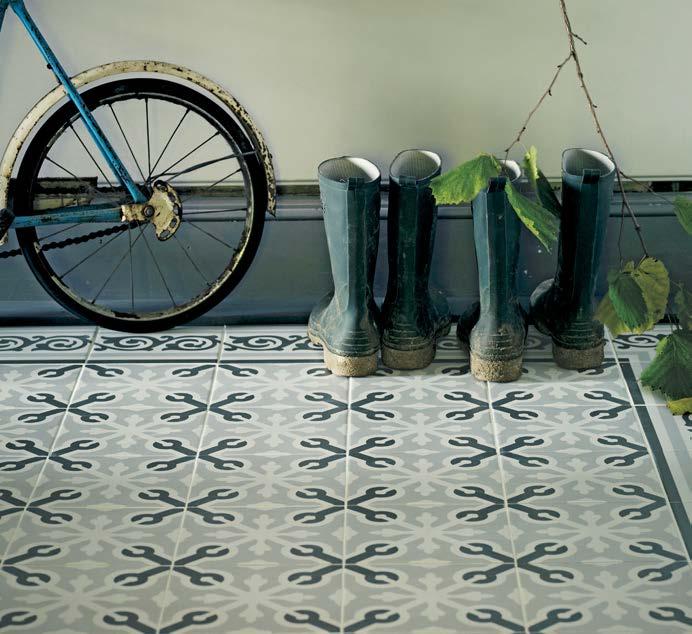
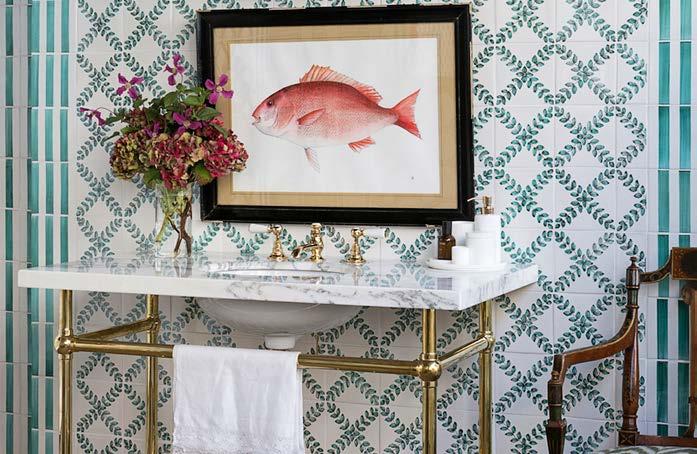
MAKE AN ENTRANCE
Geometric designs work well and provide a degree of restrained formality in entrance halls. Large, plain-coloured tiles can make a narrow hallway appear larger when laid in a classic chequerboard configuration.
Tiled floors that were hugely popular with the Victorians are ideal for creating a welcoming feel in a dark period hallway, with their intricate patterns of tiny multi-coloured tiles. Modern-day alternatives use bold designs such as hexagons, diamonds, chevrons and heraldic-style floral emblems on larger-scale tiles to dramatic effect. Source cement tiles that are at least 15mm thick and use outdoors to add a matching pathway of pattern leading up to the front door.
LEFT Orderly and elegant in their design, marble floor tiles are synonymous with grand entrance halls. A traditional monochromatic colourway also allows room for a little frivolity in the decoration with a pretty fondant pink paint colour perfect for the walls. Fitz Honed Marble tiles, £82.80 a square metre, Mandarin Stone
These colourful hand-illustrated terracotta tiles are the result of a collaboration between Balineum and artist Wayne Pate. Display singularly or as a series on shelving for some whimsical and affordable modern art. Wayne Pate Tile Collection I, from £21.60 each, Balineum
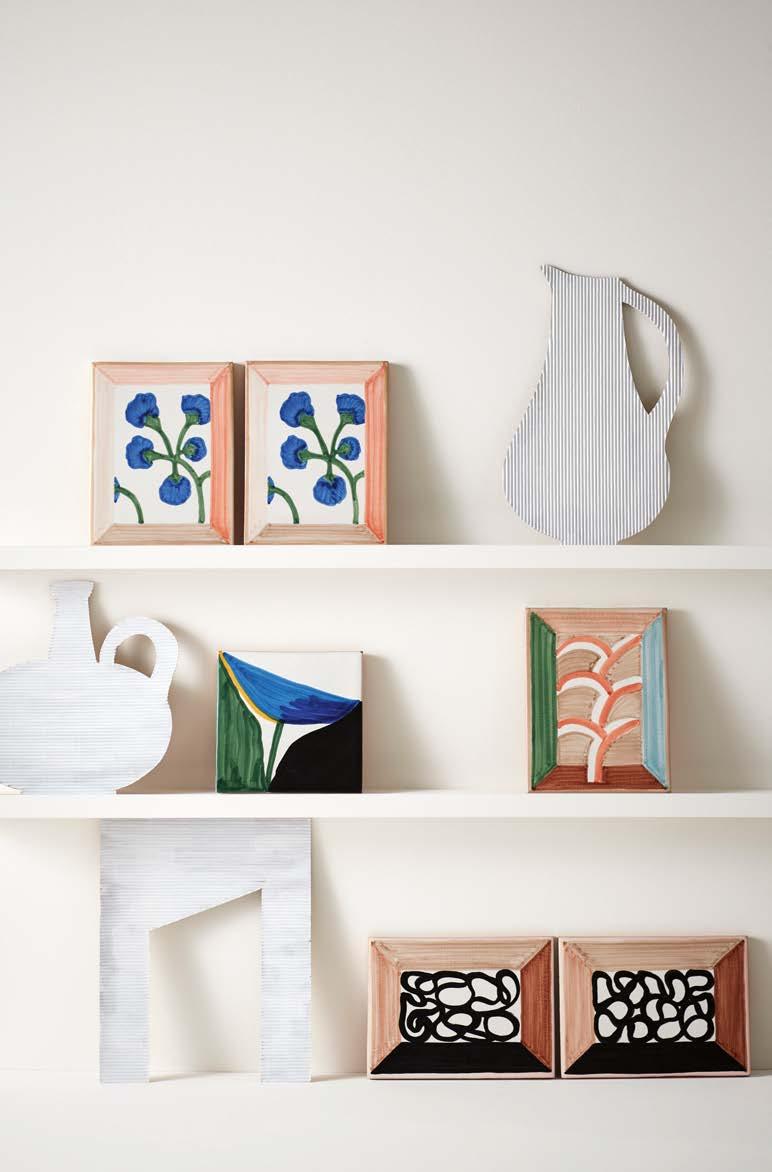
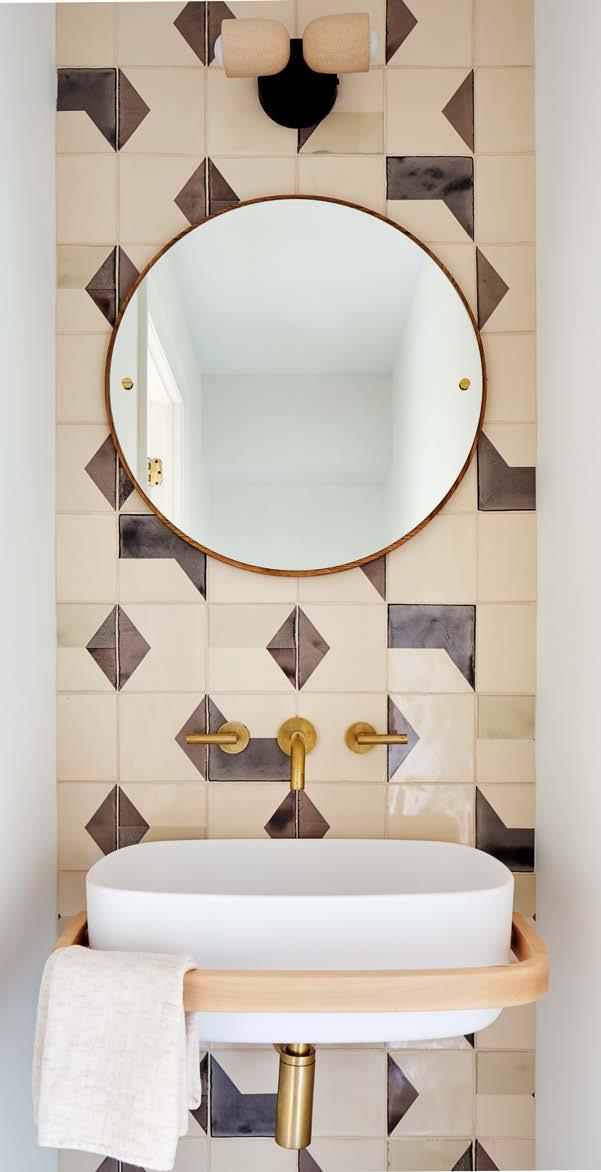
ARTISTIC OPPORTUNITY
Tiles as works of art elevate this simple and functional design staple to a whole new level. The flat clay surface lends itself to all sorts of creative illustration and expression, and artists’ handmade and hand-painted tiles can be sourced from independent galleries. The Crafts Council will also have listings of artists who specialise in this medium. Create a statement surface by forming a largescale abstract mural in a bathroom or kitchen. Alternatively, elsewhere in the home, a single, large-scale tile can be framed like a painting within plain tiles or, for a decorative installation that can be easily changed as mood dictates, place cherished pieces on shelves with other decorative objects, ceramic or otherwise.
ABOVE RIGHT Designer Marianne Smink of Smink Studio reworks classic geometric shapes to create bespoke installations. Each tile is hand-moulded and individually screen-printed. After Lowry tiles, £300 a square metre, Smink Studio
VERY MOORISH
Handmade using centuries-old traditions, encaustic clay tiles from Morocco and Europe are much revered for their raw finish. Created by pressing coloured clay into a mould, they are durable enough for exterior spaces, too.
“Encaustic cement tiles are great for period English homes, adding pattern and colour to more traditional surroundings,” Damla Turgut, founder and creative director of Otto Tiles, explains. “I particularly love the juxtaposition between contemporary and traditional styles, and their versatility. You can use them outdoors as well as indoors, on walls, floors, showers, splashbacks.”
For a similar injection of exotic charm, Turgut suggests light-reflective, high-gloss tiles such as the brand’s Zellige or Bejmat to add sparkle to an interior devoid of much natural light. The slightly uneven surface of each tile undergoes multiple layers of glaze, resulting in a beautiful pearlescent and shimmering finish.
RIGHT The beauty of the Bejmat natural clay tile lies in its hugely tactile and light-refl ective surface with tiny imperfections – a result of each one being chiselled and glazed by hand. Ecru Rose Bejmat tiles, £1.05 each, Otto Tiles
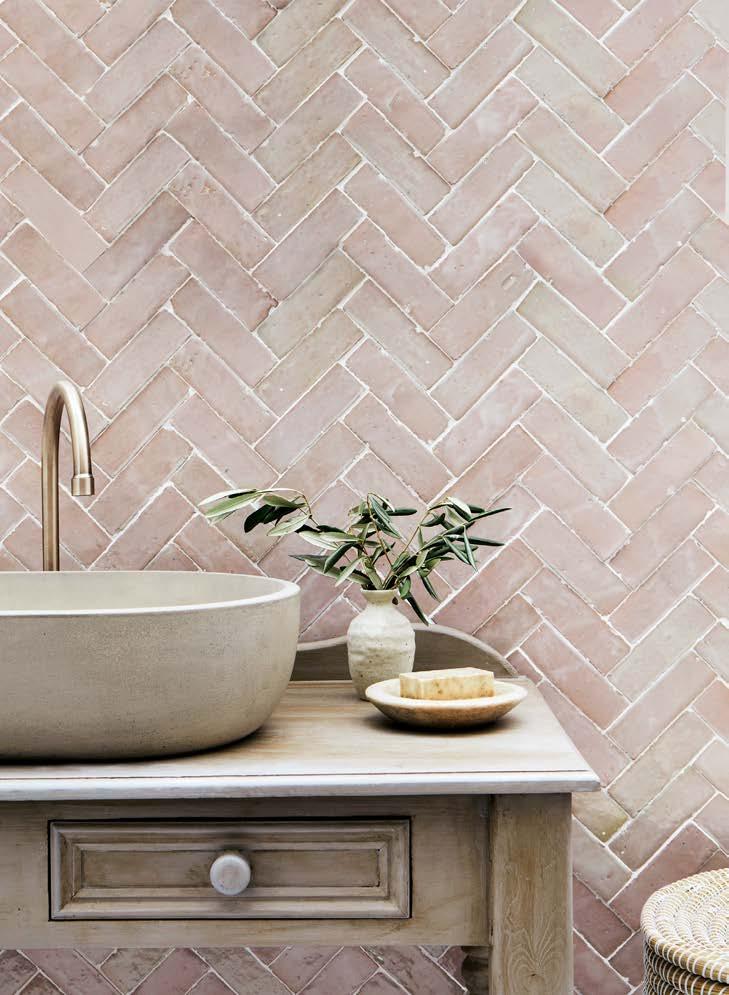

TAKE TO THE FLOOR
A tiled floor is durable and waterproof, making it the number one choice for practicality, but preparation is key, so be sure to lay onto a subfloor that is level, structurally sound, clean and dry.
Natural materials work wonders in kitchens, complementing other popular materials such as copper, steel and wood, so embrace the enduring tactile properties and colourways of stone, terracotta, limestone or slate. Source tumbled or riven slab-style cuts for a homely rustic feel, or make an urban statement with polished tiles in geometric shapes. A rustic choice on the floor could be combined with a sleek stone worktop in a kitchen.
Marble will always make a sophisticated statement, either softly with delicate grey hues or by adding drama and opulence, with deep veining in rich green or pink tones.
For a contemporary touch, consider a pale-toned, polished and scratch-resistant porcelain, or even a terrazzo-effect porcelain, with as much intricate detail as its original marble counterpart.
RIGHT Seal modern terracotta tiles with a layer of antique beeswax for an authentic feel and to allow the rich and varied tones of colour to shine. Tiles from £40 a square metre, Floors of Stone
MARVELLOUS MOSAIC

It is hard not be attracted to the idea of a mosaic when the beauty and elaborate design of such a distinctive aesthetic date back over 4,000 years in history. Made using tesserae – small pieces of glass, tile or stone – mosaic patterns can be as simple or intricate as desired.
Stone and tile mosaics are naturally suited to floors, both inside and out, or even as an inlaid panel on a table or work surface. Glass mosaic tiles come in an alluring array of colours and are a particularly attractive way to tile a wall in a wet room or bathroom. The combination of water droplets and the light-reflective qualities of the glass will create a shimmering effect.
For ease of application on large surfaces use ready-to-lay sheets of mosaic tiles. Alternatively opt for a show-stopping bespoke design as a piece of tiled art, installed on site by a specialist.
ABOVE Designed by artist Sara Baldwin, this handmade mosaic includes custom stone and glass such as emerald, tourmaline, labradorite, opal, tiger’s eye, rose quartz and pearl jewel glass. New Ravenna Chinoiserie mosaic, £5,994 a square metre, West One Bathrooms
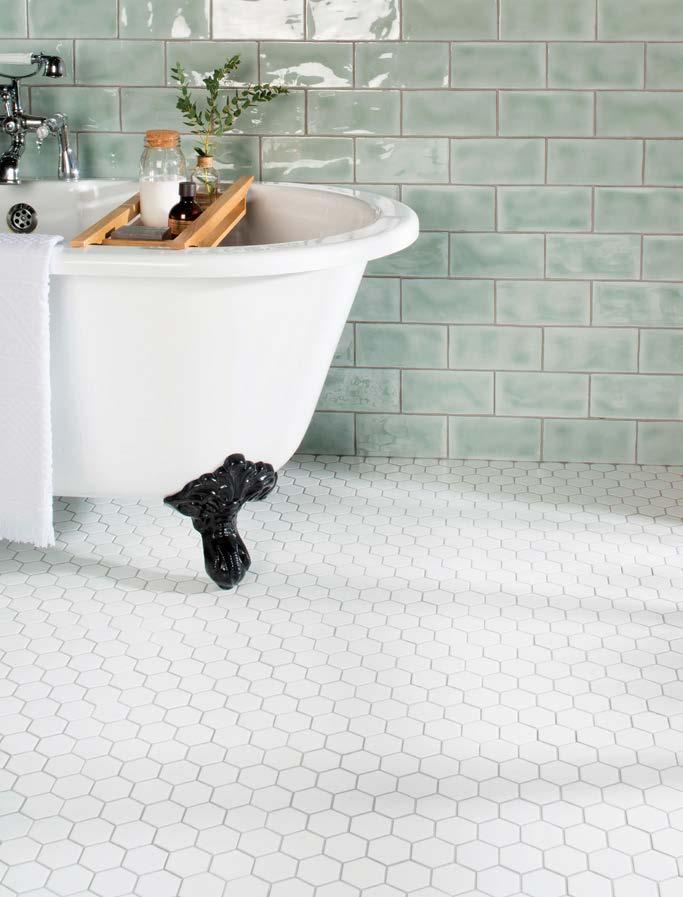
FILL IN THE GAPS
A mix of cement, lime and colour pigment, grout is a fail-safe way of sealing a tiled surface and preventing dust, water and debris getting between individual tiles. It can be used as a decorative tool, too, as it comes in a variety of different colours, allowing for plenty of creativity. Dark grey or black grout are practical options as they will not show discolouration as easily as their lighter counterparts. They will also work wonders in emphasising the clean lines of classic shapes such as squares, hexagons and brick tiles, adding an additional layer of decorative interest. Use with plain white tiles for a statement monochromatic effect. Alternatively, introduce a cheerful, contemporary note with bright colour combinations such as pink grout with grey tiles, orange grout with yellow, or blue with green for maximum visual interest.
ABOVE Grout colour can be used to unify different sizes and shapes of tiles within a single space. Here the same shade of grey has been used on the hexagonal fl oor tiles and rectangular wall tiles. Mosaic Porcelain White Hexagon tiles (378mm x 322mm), £5.45 each; Cosmopolitan Mint Brick tile, £89.95 a square metre, both Original Tiles
SELECTING TILES
Interior designers offer insights on choosing tile materials and working with pattern
PLAYFUL WITH PATTERN Textile designer and interior decorator, Susan Deliss
“I like to bring a space alive with a sophisticated combination of pattern and colour, from figurative and floral motifs, to stripes and geometrics. Patterned tiles are great as they are big on personality, but they can dominate a room. As a tiled area is relatively permanent, I always advise clients to think twice about using anything too fashionable. Antique tiles are difficult to source, but if you can get them, use them as the key style element and design the rest of the room around them. I like to enhance a room’s sense of function using patterned tiles – I had antique-looking Delft-style tiles painted with Norfolk terriers for a US client’s mud room and dog shower. A single panel of eye-catching, patterned tiles can transform a charmless kitchen or bathroom; choose the tiles first, then paint walls a really warm colour and add coloured textiles and pictures that pick up on the detail.”
TILING WITH NATURAL MATERIALS Interior designer, Robert Moore, Moore Design
“Stone and marble have been used by civilisations for centuries for their strength and beauty. They come in an array of wonderful hues and eye-catching textures, both on the surface and sometimes figured with pretty vein markings, and even with tiny fossil deposits. I love working with natural materials as this is what nature created – every single piece is different. In my London kitchen, I have used a pale blue-grey-toned French limestone which gives the look of the original flagstones that had been lost. For a client’s bathroom project, I laid the marble floor tiles on a diagonal grid to make the space feel wider and add interest whilst still being pared-down and muted in tone. Marble and stone comes in ready-formed tiles of varying sizes to solid slabs, making it more accessible to get a luxurious look that is practical too.” ■










